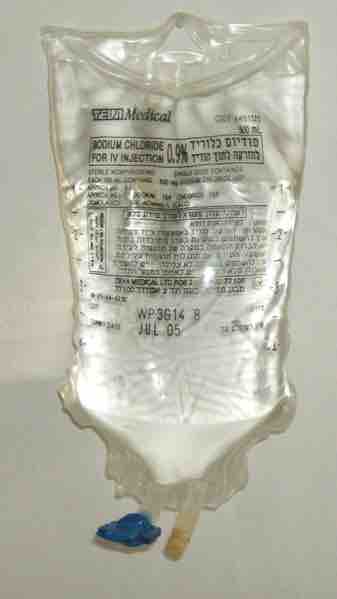The Human Solution
At normal physiological conditions, organisms regulate their internal environments and maintain stable, constant conditions despite influences from the outside environment. Internally, many mechanisms allow for a constant environment, but often, when a person becomes sick or incapacitated, the homeostatic environment becomes disrupted. To assist in the treatment and recovery process, medical scientists and doctors often introduce electrolytic solutions into the body. The solutions must be of proper osmolality and concentrations, otherwise irreversible damage can be caused. These electrolytic solutions share the same colligative properties as chemical solutions.
Saline Solutions
Medical solutions are important for treating dehydration and for cleaning and treating wounds. One class of medical solutions is known as saline solutions. These solutions are composed of water and sodium chloride. Saline solutions are typically used for rinsing contact lenses, nasal irrigation, and cleaning new piercings. Saline solutions can vary in their concentrations.
Typically, saline is found at a 0.90% w/v of NaCl in water. Referred to as "normal saline," this type of electrolytic solution is used frequently in intravenous drips for patients who have lost a lot of water and are at risk for dehydration. Normal saline is also used to treat decreased blood volume. The saline solution is expected to restore the salinity levels in the blood. Most commonly, saline is used in intravenous (IV) therapy, which provides water and electrolytes to a patient. Normal saline has low osmolality, which can introduce problems, so IV solutions generally have glucose added to maintain a safe osmolality.

Saline solution
A bag of saline. Saline can be used to increase blood volume when a blood transfusion is not possible.
Electrolytes in Solutions
As mentioned before, humans maintain a homeostatic internal environment. The electrolyte-water ratio that regulates many of the body's functions is part of this. Plasma osmolarity is the measure of the body's electrolyte-water balance. Its name is derived from osmosis, which is the net movement of solvent molecules through a partially permeable membrane; the molecules travel from a region of higher solute concentration to a region with lower solute concentration. There are two common measurements used to determine the amount of electrolyte in a solution.
Osmolality is affected by changes in water content, whereas osmolarity is affected by temperature and pressure. These two values are slightly different; osmolarity is slightly less than osmolality because it does not take into account the weight of the solutes. The normal range of osmolality in human blood plasma is 270-310 milli-osmoles/kg.
Cell membranes are permeable to water, so the osmolality of the extracellular fluid (ECF) is approximately equal to that of the intracellular fluid (ICF). Any shift in the osmolality of the ECF will directly impact the ICF and can cause problems with normal cell functions and water volume. Therefore, the introduction of saline that is too hypotonic will cause water to fill the cells too rapidly, potentially causing the cells to burst. Conversely, the introduction of saline that is too hypertonic will cause water to leave the cells, making them shrivel. There are medical solutions with a range of concentrations to ensure the cell maintains an isotonic environment.